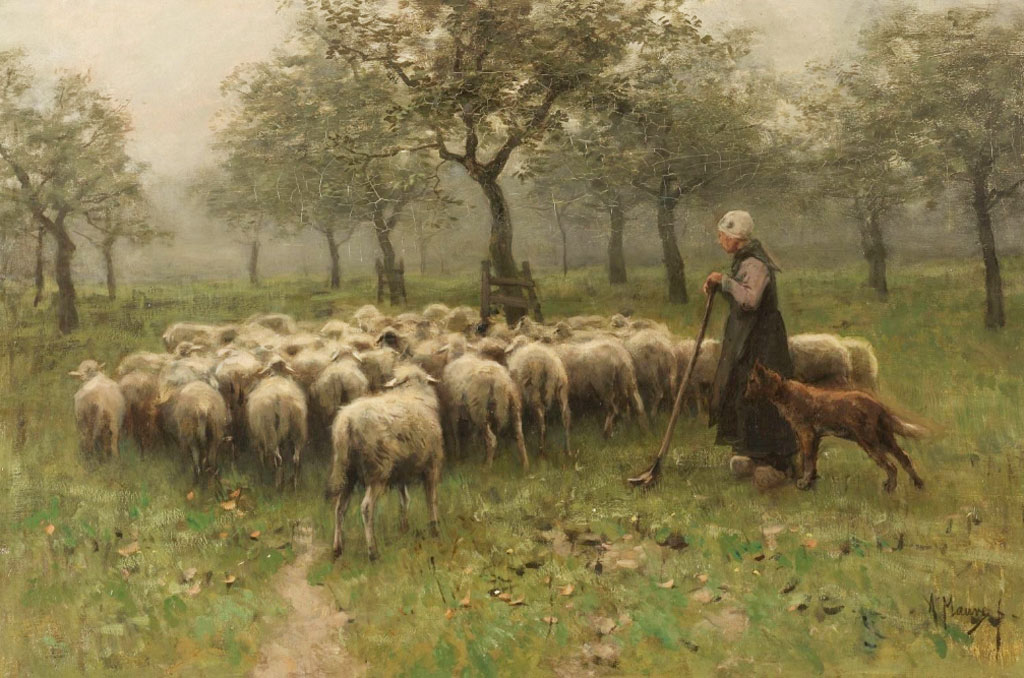
Shepherdess with a Flock of Sheep, by Anton Mauve, c. 1870-88, Dutch painting, oil on canvas
Easter 4 (Year A): John 10:1-10
Big Picture:
1) This is the fourth of the seven weeks of Eastertide. The gospel readings for the first three weeks were resurrection appearance stories; the next four weeks, between now and Pentecost, will explore Jesus’ teachings about living in intimacy with God.
2) Many early followers of Jesus would have been familiar with describing the promised Messiah as a caring and skillful “shepherd”: Isaiah, Jeremiah, and Ezekiel each use such language, and likewise, Jeremiah, Ezekiel, and Zechariah contrast the divine shepherd with “worthless shepherds” who neglect, exploit, and scatter the flock. For listeners today, Psalm 23 (this week’s psalm) is likely the best-known reference to God as a shepherd, with the “rod and staff” evoking the hazards of the wilderness: the rod for fending off wolves and lions, and the staff for rescuing sheep trapped in thickets or crevasses.
3) In the passage immediately following this one, Jesus calls himself “the good shepherd” — and the Greek word in that phrase translated as “good” (kalos) means not “morally good” but rather “real and proper” or “true,” as in, “I am the true shepherd” or “I am the genuine shepherd.” And what is that, exactly? In this week’s passage, Jesus defines “good shepherding” this way: “I came that they may have life, and have it abundantly. I am the good shepherd…” (John 10:10b-11).
4) And what is “abundant life”? As we’ll see in the weeks ahead, the abundance Jesus has in mind isn’t a life of material wealth, but rather of love and intimacy with God, like the trusting companionship of sheep and shepherd. An intimacy so close, Jesus will go on to say, as to be a kind of symbiotic communion, comparable to the relationship between a vine and its branches (John 15:5).
Takeaways:
1) Drawing on the ancient prophets, Jesus declares his identity and mission with a vivid picture. He is “the gate” to nourishment by day and safety by night; he is “the good shepherd” who cares for the sheep, who “came that they may have life, and have it abundantly” (John 10:9-11). In other words, the good shepherd loves the sheep with a tangible, down-to-earth, everyday kind of love — and the sheep, sensing this, trust and follow.
2) In this way, Jesus casts faith as a form of experiential love and trust (John 10:3-5). The sheep don’t analyze arguments; rather, they sense the shepherd’s care first-hand. They trust and follow. And over time, the sheep become “one” with the shepherd, listening and acting in concert — just as we become “one” with those we most love and trust. It’s not that we follow mindlessly; we keep our wits about us! But we sense that they have our best interests at heart, that our interests are their interests, and vice versa — and so we live in a kind of unity with them. We are “in this together,” we say, or “of one accord,” or “of one mind.” We each want the other to “have life, and have it abundantly” — and this kind of unity, intimacy, and good will, this kind of communion, is precisely what God wants to have with us (John 10:10). This is the good news of the Gospel: God is with us, and calls us to be with God, in this deep-down-to-our-toes, existential, loving, indwelling sense: “Abide in me,” Jesus says, “as I abide in you” (John 15:4). “God is my shepherd; I shall not want” (Psalm 23:1). For Jesus, that’s what “abundant life” looks like.
3) But what about those who don’t “hear Jesus’ voice” — does this mean they are somehow left out and excluded? It doesn’t, for at least two reasons. First, to cast faith as a loving, trusting relationship of communion — as something you have to enter into and experience, rather than merely think about or argue about from a distance — is at heart an open invitation, not an exclusion. It’s to say, Come in, try it out, taste and see. Or, to shift the metaphor: from outside on the street, stained-glass windows aren’t much to look at; you have to come inside and visit in order to see the artistry, color, and light. Thinking of faith in this way, then, doesn’t exclude so much as prioritize first-hand experience, relationship, and participation. And second, in Jesus’ “good shepherd” teaching (indeed just a few verses after this week’s passage), he goes out of his way to warn his followers against exclusionary assumptions: “I have other sheep,” he says, “that do not belong to this fold” (John 10:16). We dare not put limits — religious or otherwise — on God’s love and care!
